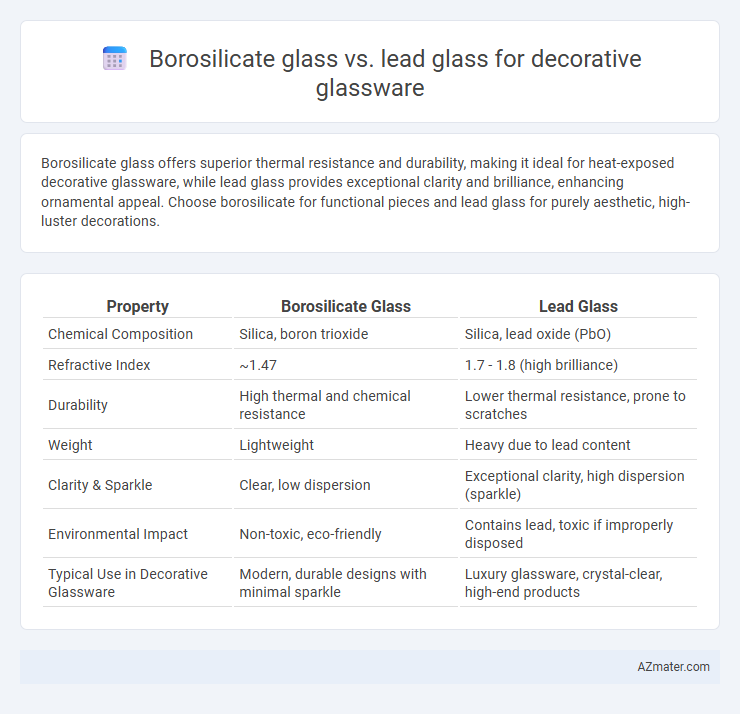Borosilicate glass offers superior thermal resistance and durability, making it ideal for heat-exposed decorative glassware, while lead glass provides exceptional clarity and brilliance, enhancing ornamental appeal. Choose borosilicate for functional pieces and lead glass for purely aesthetic, high-luster decorations.
Table of Comparison
| Property | Borosilicate Glass | Lead Glass |
|---|---|---|
| Chemical Composition | Silica, boron trioxide | Silica, lead oxide (PbO) |
| Refractive Index | ~1.47 | 1.7 - 1.8 (high brilliance) |
| Durability | High thermal and chemical resistance | Lower thermal resistance, prone to scratches |
| Weight | Lightweight | Heavy due to lead content |
| Clarity & Sparkle | Clear, low dispersion | Exceptional clarity, high dispersion (sparkle) |
| Environmental Impact | Non-toxic, eco-friendly | Contains lead, toxic if improperly disposed |
| Typical Use in Decorative Glassware | Modern, durable designs with minimal sparkle | Luxury glassware, crystal-clear, high-end products |
Introduction to Decorative Glassware Materials
Borosilicate glass offers high thermal resistance and durability, making it ideal for decorative glassware requiring strength and clarity. Lead glass, known for its brilliance and weight, enhances light refraction, producing exquisite sparkle in ornamental pieces. Selecting between borosilicate and lead glass depends on the desired balance of resilience and aesthetic appeal in decorative applications.
What is Borosilicate Glass?
Borosilicate glass is a type of glass known for its exceptional thermal resistance and durability, composed primarily of silica and boron trioxide. It is widely used in decorative glassware due to its resistance to thermal shock and chemical corrosion, making it ideal for intricate designs that require strength and clarity. Compared to lead glass, borosilicate glass is less dense and free from lead content, offering a safer, eco-friendly alternative with high optical quality and longevity.
What is Lead Glass?
Lead glass, also known as lead crystal, contains a high percentage of lead oxide, typically between 18-40%, which enhances its refractive index and brilliance, making it highly prized for decorative glassware. Its remarkable clarity, weight, and ability to be intricately cut or etched distinguish it from borosilicate glass, which prioritizes durability and thermal resistance over aesthetic sparkle. The inclusion of lead results in a softer, more malleable glass that produces a distinctive sparkling effect, ideal for luxury items like vases, chandeliers, and fine glass ornaments.
Aesthetic Differences: Borosilicate vs Lead Glass
Borosilicate glass offers a clear, durable aesthetic with a subtle gloss and excellent resistance to thermal shock, making it ideal for modern, minimalist decorative glassware. Lead glass, known as crystal, provides superior brilliance and a high refractive index, resulting in sparkling clarity and intricate light refraction that enhances ornamental appeal. The choice between borosilicate and lead glass significantly affects the visual elegance and light play in decorative pieces, with lead glass favored for luxury and traditional designs, while borosilicate suits contemporary, functional decor.
Durability and Strength Comparison
Borosilicate glass offers superior durability and resistance to thermal shock, making it more resilient against breakage and suitable for decorative glassware exposed to temperature fluctuations. Lead glass, while visually appealing due to its high refractive index and brilliance, tends to be softer and more prone to scratching and chipping, reducing its overall strength. The enhanced durability of borosilicate glass ensures longer-lasting decorative pieces, especially in environments requiring robust performance.
Clarity and Light Refraction Properties
Borosilicate glass offers exceptional clarity with low iron content, resulting in minimal color distortion and high resistance to thermal stress, making it ideal for decorative glassware requiring durability and pristine appearance. Lead glass, containing higher lead oxide levels, provides superior light refraction and brilliance, producing a sparkling effect that enhances the ornamental appeal of glassware. While borosilicate prioritizes clarity and strength, lead glass excels in creating dazzling visual effects through enhanced refractive properties.
Safety and Toxicity Concerns
Borosilicate glass offers superior chemical resistance and thermal stability, making it a safer choice for decorative glassware compared to lead glass, which contains toxic lead oxide that can leach into the environment or pose health risks upon prolonged exposure. Lead glass is often heavier and more refractive, enhancing aesthetic appeal but raising concerns about lead poisoning, especially if the glassware is chipped or used for food and drink. For health-conscious consumers, borosilicate glass provides a non-toxic alternative that combines durability with safety, minimizing potential toxicity associated with lead glass.
Versatility in Decorative Applications
Borosilicate glass offers high thermal and chemical resistance, making it ideal for intricate decorative glassware that requires durability and frequent handling. Lead glass provides superior brilliance and clarity, enhancing ornamental appeal with its high refractive index, but its fragility limits versatility in functional decorative pieces. The balance between borosilicate's robustness and lead glass's aesthetic brilliance defines their distinct roles in diverse decorative applications.
Price and Availability Comparison
Borosilicate glass, known for its thermal resistance and durability, typically costs more than lead glass, which is prized for its brilliance and clarity but is less heat-resistant. Lead glass is widely available in decorative glassware due to its traditional use and lower production costs. Borosilicate glass may have limited availability in decorative items as it is more commonly used in scientific and kitchenware applications, making lead glass more accessible and affordable for decorative purposes.
Choosing the Best Glass for Decorative Purposes
Borosilicate glass offers exceptional thermal and chemical resistance, making it ideal for durable and long-lasting decorative glassware, especially where heat exposure is a concern. Lead glass, known for its high refractive index and brilliance, provides superior sparkle and clarity, enhancing aesthetic appeal for ornamental pieces. Selecting the best glass depends on balancing durability needs with desired visual effects, where borosilicate suits functional decor and lead glass excels in luxurious, visually striking designs.

Infographic: Borosilicate glass vs Lead glass for Decorative glassware
 azmater.com
azmater.com